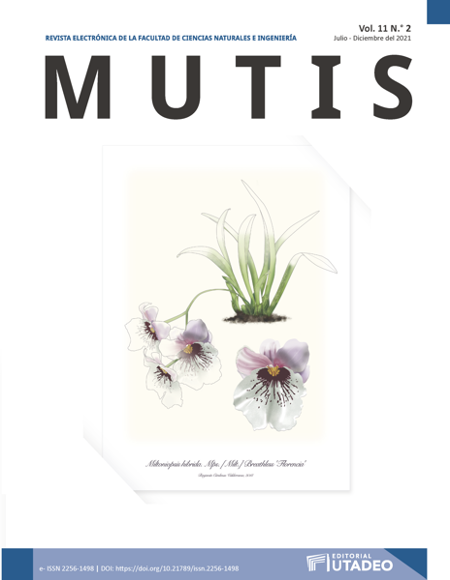
Esta obra está bajo una licencia internacional Creative Commons Atribución-NoComercial-CompartirIgual 4.0.
Esta obra está bajo una licencia internacional Creative Commons Atribución-NoComercial-CompartirIgual 4.0.
Resumen
El canto de las aves es fundamental para la comunicación y el desarrollo de diferentes actividades. Por otra parte, el ruido que proviene de diversas fuentes dificulta su recepción, por lo cual algunas aves cambian la estructura, frecuencia, energía o el horario de su canto con el fin de asegurar ser escuchadas. Particularmente, el ruido generado por ríos es constante y tiene mayor intensidad a bajas frecuencias, por lo que puede enmascarar el canto. Por consiguiente, el objetivo de este trabajo fue analizar el canto de Myiothlypis fulvicauda en ambientes con ruido natural generado por cuerpos de agua en el municipio de Ibagué (Tolima), teniendo en cuenta además la temporada climática y el grado de cobertura vegetal. Las grabaciones se realizaron en los meses de mayo, julio y octubre de 2019 en 8 localidades, estableciendo dos tratamientos de ruido, alto y bajo. Se emplearon modelos lineales generalizados, así como análisis de varianza y correlación, para evaluar el efecto del ruido, la temporada climática y el grado de cobertura vegetal sobre el canto de esta ave. Se encontró que la frecuencia máxima, el rango de frecuencias y el número de silbidos iniciales fueron mayores en hábitats con ruido alto. A su vez, el rango de frecuencias fue menor durante la temporada seca. Por su parte, el número de elementos repetitivos y las frecuencias máximas también fueron menores en localidades con vegetación más densa. Estos cambios en el canto de M. fulvicauda denotan una posible adaptación de la especie como respuesta al ruido y a características de su hábitat tales como la cobertura vegetal y la temporada climática.
Citas
Brumm, H. (2013). Animal communication and noise (vol. 2). Springer Berlin Heidelbert. https://doi.org/10.1007/978-3-642-41494-7
Brumm, H., & Naguib, M. (2009). Chapter 1. Environmental acoustics and the evolution of bird song. En Advances in the Study of Behavior (1a ed., vol. 40, núm. 09) (pp 1-33). Elsevier Inc. https://doi.org/10.1016/S0065-3454(09)40001-9
Brumm, H., & Slabbekoorn, H. (2005). Acoustic communication in noise. Advances in the Study of Behavior, 35(05), 151-209. https://doi.org/10.1016/S0065-3454(05)35004-2
Brumm, H., & Slater, P. J. B. (2006). Ambient noise, motor fatigue, and serial redundancy in chaffinch song. Behavioral Ecology and Sociobiology, 60(4), 475-481. https://doi.org/10.1007/s00265-006-188y
Catchpole, C., & Slater, P. (2008). Bird song. Biological themes and variations (2a ed.). Cambridge University Press. https://doi.org/10.1017/CBO9780511754791
Center for Conservation Bioacoustics [CCB]. (2014). Raven Pro: Interactive sound analysis software (Version 1.5) [Computer software]. The Cornell Lab of Ornithology. http://ravensoundsoftware.com/
Douglas, H. D., & Conner, W. E. (1999). Is there a sound reception window in coastal environments? Evidence from shorebird communication systems. Nature Wissens Chaften, 86(5), 228-230. https://doi.org/10.1007/s001140050603
Escalante, I. (2013). Comportamiento de canto, descripción de las vocalizaciones y su posible variación geográfica en Costa Rica en Myiothlypis fulvicauda. Zeledonia, 17(1), 35-53. http://www.avesdecostarica.org/uploads/7/0/1/0/70104897/17-1-000-dig.pdf#page=37
Farina, A., & Gage, S. H. (2017). Ecoacoustics: The ecological role of sounds. Wiley. https://doi.org/10.1002/9781119230724
Fernández-Juricic, E., Poston, R., De-Collibus, K., Morgan, T., Bastain, B., Martin, C., Jones, K., & Treminio, R. (2005). Microhabitat selection and singing behavior patterns of male house finches (Carpodacus mexicanus) in urban parks in a heavily urbanized landscape in the Western U.S. Urban Habitats, 3(1), 49-69.
Gill, F. (2007). Ornithology (3a ed). W. H. Freeman and Company.
Gough, D. C., Mennill, D. J., & Nol, E. (2014). Singing seaside: Pacific wrens (Troglodytes pacificus) change their songs in the presence of natural and anthropogenic noise. The Wilson Journal of Ornithology, 126(2), 269-278. https://doi.org/10.1676/13-088.1
Handford, P., & Lougheed, S. (1991). Variation in duration and frequency characters in the song of the Rufous-collared sparrow, Zonotrichia capensis, with respect to habitat, trill dialects and body size. The Condor, 93(3), 644-658. https://doi.org/10.2307/1368196
Hart, P. J., Hall, R., Ray, W., Beck, A., & Zook, J. (2015). Cicadas impact bird communication in a noisy tropical rainforest. Behavioral Ecology, 26(3), 839-842. https://doi.org/10.1093/beheco/arv018
Hilty, S., & Brown, W. (2001). Guía de las aves de Colombia (H. Álvarez-López, trad.). American Bird Conservancy-ABC.
Holdridge, L. (1967). Life zone ecology. Tropical Science Center.
Instituto de Hidrología, Meteorología y Estudios Ambientales [IDEAM]. (2019, julio 7). Banco de datos estaciones automáticas. IDEAM.
Kirschel, A. N. G., Blumstein, D. T., Cohen, R. E., Buermann, W., Smith, T. B., & Slabbekoorn, H. (2009). Birdsong tuned to the environment: Green hylia song varies with elevation, tree cover, and noise. Behavioral Ecology, 20(5), 1089-1095. https://doi.org/10.1093/beheco/arp101
Londoño, C. A. E., & Fernández, A. E. G. (2011). Protocolo para medir la emisión de ruido generado por fuentes fijas. Revista Ingenierias Universidad de Medellín, 10(18), 51-60. http://www.scielo.org.co/pdf/rium/v10n18/v10n18a06.pdf
Luther, D. A., Phillips, J., & Derryberry, E. P. (2016). Not so sexy in the city: Urban birds adjust songs to noise but compromise vocal performance. Behavioral Ecology, 27(1), 332-340. https://doi.org/10.1093/beheco/arv162
Melo, O., & Vargas, R. (2002). Evaluación ecológica y silvicultural de ecosistemas boscosos. Universidad del Tolima, CRQ, CARDER, Corpocaldas, Cortolima. http://academia.ut.edu.co/images/archivos/Fac_Forestal/Documentos/LIBROS/evalucaion%20de%20ecosistemas%20boscosos%20%20Rafael%20vargas%20y%20Omar%20mel.pdf
Mendes, S., Colino-Rabanal, V. J., & Peris, S. J. (2017). Adaptación acústica del canto de Turdus leucomelas (Passeriformes: Turdidae) a diferentes niveles de ruido antrópico, en el área metropolitana de Belém, Pará, Brasil. Revista de Biologia Tropical, 65(2), 633-642. https://doi.org/10.15517/rbt.v65i2.25721
Mendoza, A. M., & Arce-Plata, M. I. (2012). Aproximación al impacto de la perturbación urbana en las vocalizaciones de Pitangus sulphuratus (Tyrannidae) en Santiago de Cali, Valle del Cauca (Colombia). Revista de Ciencias, 16, 19-29. https://doi.org/10.25100/rc.v16i0.500
Morton, E. S. (1975). Ecological sources of selection on avian sounds. The American Naturalist, 109(965), 17-34. https://doi.org/10.1086/282971
Naguib, M. (2003). Reverberation of rapid and slow trills: Implications for signal adaptations to long-range communication. The Journal of the Acoustical Society of America, 113(3), 1749-1756. https://doi.org/10.1121/1.1539050
Narins, P. M., Feng, A. S., Lin, W., Schnitzler, H. U., Denzinger, A., Suthers, R. A., & Xu, C. (2004). Old World frog and bird vocalizations contain prominent ultrasonic harmonics. The Journal of the Acoustical Society of America, 115(2), 910-913. https://doi.org/10.1121/1.1636851
Nicholls, J. A., & Goldizen, A. W. (2006). Habitat type and density influence vocal signal design in satin bowerbirds. Journal of Animal Ecology, 75(2), 549-558. https://doi.org/10.1111/j.1365-2656.2006.01075.x
Pacifici, K., Simons, T. R., & Pollock, K. H. (2008). Effects of vegetation and background noise on the detection process in auditory avian point-count surveys. The Auk, 125(3), 600-607. https://doi.org/10.1525/auk.2008.07078
Pijanowski, B. C., Farina, A., Gage, S. H., Dumyahn, S. L., & Krause, B. L. (2011). What is soundscape ecology? An introduction and overview of an emerging new science. Landscape Ecology 26, 1213-12332. https://doi.org/10.1007/s10980-011-9600-8
R Core Team. (2019). R: A language and environment for statistical computing. R Foundation for statistical Computing. https://www.R-project.org/
Sánchez-Guzmán, J. N., & Losada-Prado, S. (2016). Características de la avifauna en un fragmento de bosque húmedo premontano afectado por ruido vehicular. Mutis, 6(2), 7-18. http://dx.doi.org/10.21789/22561498.1147
Sánchez-Rodríguez, E., López-Mata, L., García-Moya, E., & Cuevas-Guzmán, R. (2003). Estructura, composición florística y diversidad de especies leñosas de un bosque mesófilo de montaña en la Sierra de Manantlán, Jalisco. Boletín de la Sociedad Botánica de México, 73, 17-34. https://www.redalyc.org/articulo.oa?id=57707302
Schäfer, J. E., Janocha, M. M., Klaus, S., & Tietze, D. T. (2017). How weather instead of urbanity measures affects song trait variability in three European passerine bird species. Ecology and Evolution, 7(13), 4868-4880. https://doi.org/10.1002/ece3.3032
Slabbekoorn, H., & Peet, M. (2003). Birds sing at a higher pitch in urban noise. Nature, 424, 267-268. https://doi.org/10.1038/424267a
Snell-Rood, E. C. (2012). The effect of climate on acoustic signals: Does atmospheric sound absorption matter for bird song and bat echolocation? The Journal of the Acoustical Society of America, 131(2), 1650-1658. https://doi.org/10.1121/1.3672695
Secretaría de Planeación y TIC [SPT]. (2014). Estadísticas 2011-2014. Gobernación del Tolima/Universidad de Ibagué. https://www.tolima.gov.co/descargar.php?idFile=2474
Swaddle, J. P., & Page, L. C. (2007). High levels of environmental noise erode pair preferences in zebra finches: Implications for noise pollution. Animal Behaviour, 74(3), 363-368. https://doi.org/10.1016/j.anbehav.2007.01.004
Vargas-Salinas, F., Dorado-Correa, A., & Amézquita, A. (2014). Microclimate and stream noise predict geographic divergence in the auditory signal of a threatened poison frog. Biotropica, 46(6), 748-755. https://doi.org/10.1111/btp.12169
Descargas
Datos de publicación
Perfil evaluadores/as N/D
Declaraciones de autoría
- Sociedad académica
- Universidad de Bogotá Jorge Tadeo Lozano
- Editorial
- Universidad de Bogotá Jorge Tadeo Lozano

 PDF
PDF
 FLIP
FLIP
 XML
XML













